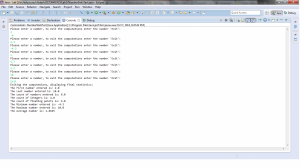Description:
Based on the lecture, Chapter 3 introduced us to a bit more of what java is about as its classes, objects, methods and strings; Chapter 6 went a bit further into methods. Using this valuable information, each individual had to create a java program that will compute several statistics. Unlike Lab 1, we had to create two different classes for two different purposes; one, called NumberStats, that provides several methods to compute the several statistics and the other, the client of NumberStats, as an application. Thia application instantiates an object of NumberStats and displays a menu that will prompt the user to (1) enter a number or (2) exit the program. More importantly, when the user exits the program the different statistics will be displayed by using the appropriate methods.
Code:
package edu.cuny.citytech.CET3640.f13.Lab2;
public class NumberStats
{
private double firstnum;
private double lastnum;
private double min;
private double max;
private double sum;
private double avg;
private double countnum;
private double intnum;
private double floatnum;
private double FloorValue;
private double CeilingValue;
public NumberStats()
{
firstnum = 0;
lastnum = 0;
min = 0;
max = 0;
sum = 0;
intnum = 0;
floatnum = 0;
countnum = 0;
}
public void setNumberStats(double newnumber, int count)
{
this.lastnum = newnumber;
sum += newnumber;
if (count == 1) {
min = newnumber;
max = newnumber;
firstnum = newnumber;
}
if (min >= newnumber) {
min = newnumber;
}
if (max <= newnumber) {
max = newnumber;
}
this.avg = sum/count;
this.countnum = count;
this.FloorValue = Math.floor(newnumber);
this.CeilingValue = Math.ceil(newnumber);
if (FloorValue <= newnumber && CeilingValue <= newnumber )
{
intnum++;
}
else
{
floatnum++;
}
}
public double getfirstnum() {
return firstnum;
}
public double getlastnum() {
return lastnum;
}
public double getmin() {
return min;
}
public double getmax() {
return max;
}
public double getavg() {
return avg;
}
public double getcountnum(){
return countnum;
}
public double getintnum(){
return intnum;
}
public double getfloatnum(){
return floatnum;
}
public double getFloorValue(){
return FloorValue;
}
public double getCeilingValue(){
return CeilingValue;
}
public void displayStatistics()
{
System.out.println("The First number entered is: " + getfirstnum());
System.out.println("The Last number entered is: " + getlastnum());
System.out.println("The count of numbers entered is: " + getcountnum());
System.out.println("The count of integers is: " + getintnum());
System.out.println("The count of floating points is: " + getfloatnum());
System.out.println("The Minimum number entered is: " + getmin());
System.out.println("The Maximum number entered is: " + getmax());
System.out.println("The Average number is: " + getavg());
}
}
package edu.cuny.citytech.CET3640.f13.Lab2;
import java.util.Scanner;
public class NumberStatsTest {
public static int count = 1;
private static Scanner scanner;
public static void main(String[] args)
{
NumberStats StatsTest = new NumberStats();
scanner = new Scanner(System.in);
do
{
System.out.println("Please enter a number, to exit the computations enter 'Exit':");
StatsTest.setNumberStats(scanner.nextDouble(), count);
if(scanner.hasNext("Exit"))
{
System.out.println("Exiting the computations, displaying final statistics: ");
StatsTest.displayStatistics();
break;
}
if(scanner.hasNext("exit"))
{
System.out.println("Exiting the computations, displaying final statistics: ");
StatsTest.displayStatistics();
break;
}
count++;
}
while(true);
}
}
Screenshots:




